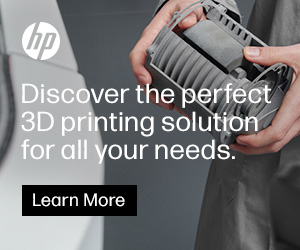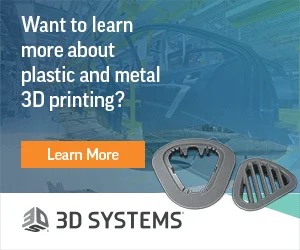Moog and University at Buffalo Developing Artificial Intelligence for Image Recognition in Metal 3D Printing
![]() 3D printing is used increasingly in projects that require some type of recognition – for instance, CENIT’s 3D software tool can analyze a topologically optimized component and allocate it to the correct bionic component in a CAD catalog, and a cyber security firm fooled the iPhone X facial recognition system with a 3D printed mask. Now, motion control technology provider Moog is teaming up with the University at Buffalo, part of the SUNY System and no stranger to 3D printing, to develop artificial intelligence (AI) for image recognition in metal 3D printing.
3D printing is used increasingly in projects that require some type of recognition – for instance, CENIT’s 3D software tool can analyze a topologically optimized component and allocate it to the correct bionic component in a CAD catalog, and a cyber security firm fooled the iPhone X facial recognition system with a 3D printed mask. Now, motion control technology provider Moog is teaming up with the University at Buffalo, part of the SUNY System and no stranger to 3D printing, to develop artificial intelligence (AI) for image recognition in metal 3D printing.
 Metal 3D printing is undeniably on the rise these days, and is frequently among the major themes at industry events. The advanced manufacturing technology makes it possible to create metal parts with complex geometries at a faster rate, but it’s not foolproof, which is why we still often hear about ongoing research and development efforts centered around advancing and improving the technology.
Metal 3D printing is undeniably on the rise these days, and is frequently among the major themes at industry events. The advanced manufacturing technology makes it possible to create metal parts with complex geometries at a faster rate, but it’s not foolproof, which is why we still often hear about ongoing research and development efforts centered around advancing and improving the technology.
Process development and control are important components in the process of 3D printing critical metal parts, and even when industrial statistical techniques, such as the Design of Experiments (DoE), are applied, the amount of experimental work to be done is vast, requiring lots of time in the laboratory inspecting sample parts under a microscope, or through X-ray CT scans. And as we know, human vision is not always 100% accurate.
While Moog has been spending time making process improvements in order to reduce this tiring experimental workload, Professor Rahul Rai, with the University at Buffalo’s Department of Mechanical and Aerospace Engineering, has been using AI to master image recognition in metal 3D printing.
The collaborative team of Professor Rai and engineers from Moog received funding from the UB New York State Center of Excellence in Materials Informatics (CMI) for their experimental work, and successfully applied convolutional neural networks to parts 3D printed out of metal. This resulted in a trained computer algorithm which is able to not only recognize metal 3D printed parts with high quality, but also reject ones with lower quality; you can see an illustration of this in the diagram below.
This diagram was reconstructed out of nearly 150 sub images, which were evaluated and colored individually by the new algorithm. Of 144 sub images, 136 were inspected and deemed “undermelt” by the AI algorithm, while six were classified as “overmelt.”
These terms – undermelt and overmelt – are non-optimal conditions that are not often used in the manufacturing of production parts. However, the undermelt in these cases was expected, as the process parameters which were employed to create the 136 images did not result in enough energy.
As a result of their collaboration, UB and Moog now have a computerized inspection tool that’s been trained to recognize high-quality metal 3D printed parts. Employing this tool will allow Moog to continue increasing the quality of metal 3D printed by running more experiments and closely inspecting the results.
Engineers at Moog are now making efforts to use the technology, which could have a major impact in the robotics field, in other areas, such as training the navigation system of an autonomous vehicle to recognize trees as obstacles from digital photographs, then employ that recognition in order to plan a smooth course around them.
Discuss this and other 3D printing topics at 3DPrintBoard.com or share your thoughts in the Facebook comments below.
[Source/Images: Moog]
Subscribe to Our Email Newsletter
Stay up-to-date on all the latest news from the 3D printing industry and receive information and offers from third party vendors.
You May Also Like
3D Printing Webinar and Event Roundup: March 30, 2024
Things are slowing down a little this week, but there are still several interesting 3D printing webinars and events for you to attend. Read on for all the details! 3D...
Mark Peng Tackles Both Sides of the SLA 3D Printing Market: Printers and Materials
Anyone who has been involved in stereolithography (SLA) for the past decade or more has witnessed the technology’s rapid evolution. The broader category, vat photopolymerization (VP), has grown to include...
Why ‘Chemistry for Dentistry’ Is Really Revolutionary – AMS Speaker Spotlight
Do you remember when the boundaries of the term “revolutionary” was limited to historic achievements like a war of independence, the polio vaccine, or the invention of the internet. In...
Ash’s Declassified Survival Guide to Running a 3D Printing Makerspace
So, you just got a new job running a makerspace, or you’re interested in starting one. Great! But, now what? A makerspace is essentially a place where you make things,...



































